Lytham Windmill in the 19th Century
|
|
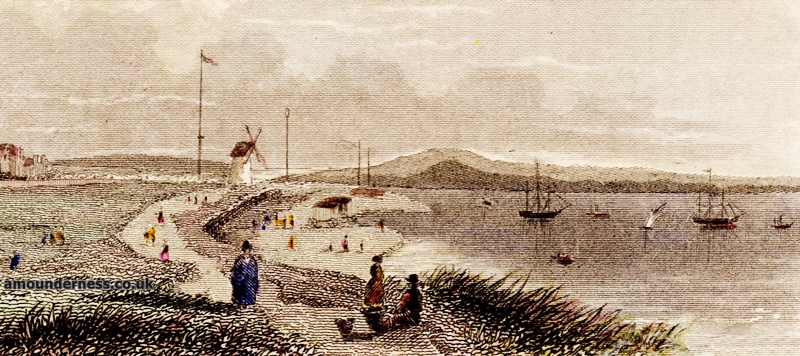
Lytham Windmill was built on the edge of
The Marsh (now Lytham Green).
Lytham windmill was erected on the Marsh about 1805. "The Marsh"
may once have been a salt marsh but by 1800 it had long since been covered by
wind-blown sand. It was an expanse of small sand dunes between the beach
and Lytham village. When Lytham developed into a holiday resort the dunes were
levelled and grassed over to form the present greensward.
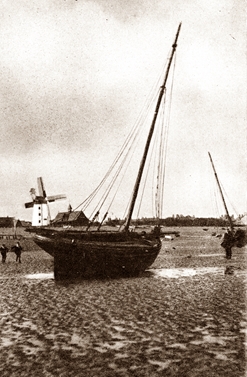
Lytham viewed from the beach c1904.
The site was advantageous for the sea breeze required to
drive the sails, and for the proximity to the sea, as grain could be
transported along the coast and delivered almost to the door of the mill. This was
often the most efficient way of transporting heavy goods due to the poor state
of many roads at the time.
|
|
1830s
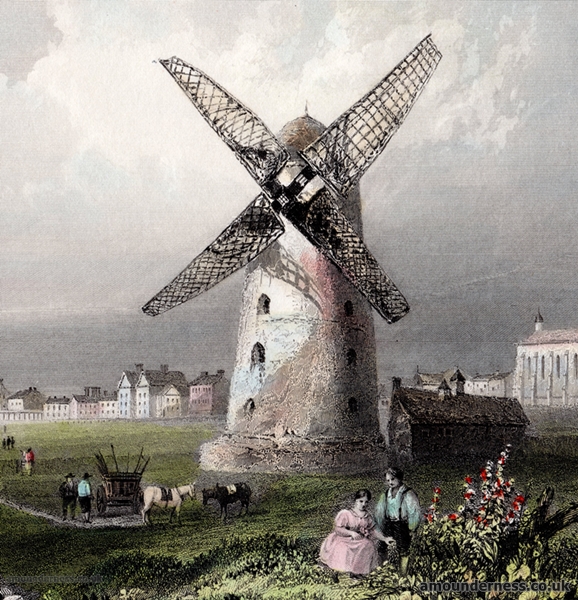
The windmill had been erected by the local landowners,
the Clifton Estate, and it was initially leased to Richard Cookson for 7/- per
annum. Originally there was a kiln on the inland side, where the
grain was dried before being milled. The sails were longer than those
depicted by the artist in this engraving of c1842. The tips almost touched the
ground on the surrounding plinth; and over the years this was the cause
of at least three tragic accidents.
|
Shocking Accident
On Saturday last a sad accident happened at
Lytham windmill. Readers acquainted with the neighbourhood are
aware that the sails of the mill revolve very near ground; and it
appears that a number of boys were on Saturday playing about in
childish bravado, trying how near they could approach the sails and
avoid injury.
At length, one of the party, a boy about six
years of age, son of George Miller, the Preston carrier, made a
false step, and the sails coming in contact with him, he was killed
on the spot.
Lancaster Gazette - Saturday 13
February 1836
|
|
|
1840s
By the 1840s, Lytham was fast developing as a health resort and
substantial properties were being erected on the seafront. The noise from the
windmill and the smoke from the kiln furnace were viewed as a nuisance by the
new residents. The kiln was taken down and rebuilt at the East End of
Lytham.
|
|
1850s
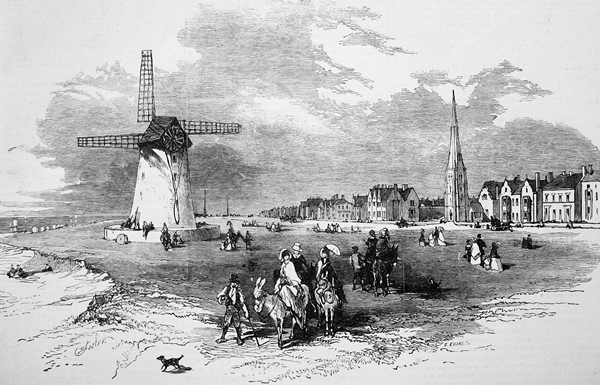
Lytham in 1856.
Thomas Moore (b.1791) was the miller at Hoo Hill Windmill, near
Blackpool, in the 1840s and then at Lytham Windmill in the 1850s. He lived in
Market Square with his wife, Mary and son John (1831-1858). He retired aged about
71, by which time he was living in "Gas Street".
|
MEMORIES OF LYTHAM WINDMILL IN THE
1850s
Many a time have I lain on the sward at its foot
listening to and watching the rumbling swift descent of its huge
arms and the swish as they grazed the long grass growing on the
platform or round terrace on which the mill stood and wondering
whether it would be possible to grip hold of the ladder-like
lattice of the arms and be whirled round and then let go at the
right moment as earth was reached again.
Our mother told us that the Clifton tenantry was
bound to grind its corn at the mill and that all millers' horses
were proverbially fat, but the miller seemed to us to be but a lean
and surly sort of churl, who thought all boys were imps of Satan
instead of being innocent little angel-lambs!
Once or twice, however, when the mill was
working well, and he was in a good humour in consequence, we coaxed
him into taking us inside and showing us with pride how the corn
ran out of a big hopper up aloft to the revolving stones, whence it
dribbled and trickled down through other hoppers and sieves, and
finally into the sacks at the bottom.
He even let us out on to the little platform
behind at the top, where the steering gear was, and whence we had a
fine view all over the country.
Extract from an article by
H.T.Crofton, Manchester City News, 1919 in which he reminisces
about Lytham in the 1850s.
|
|
Extraordinary Yield of
Grain.
Mr. Richard Swarbrick, of the Heyhouses, Lytham,
has this week had ten sacks of oats converted into meal at the
Lytham mill, which yielded seven loads, four scores, and three
pounds, of a very superior quality. The oats were grown on a sandy
soil, on Mr. Swarbrick's farm.
Blackburn Standard
- Wednesday 09 September 1857
|
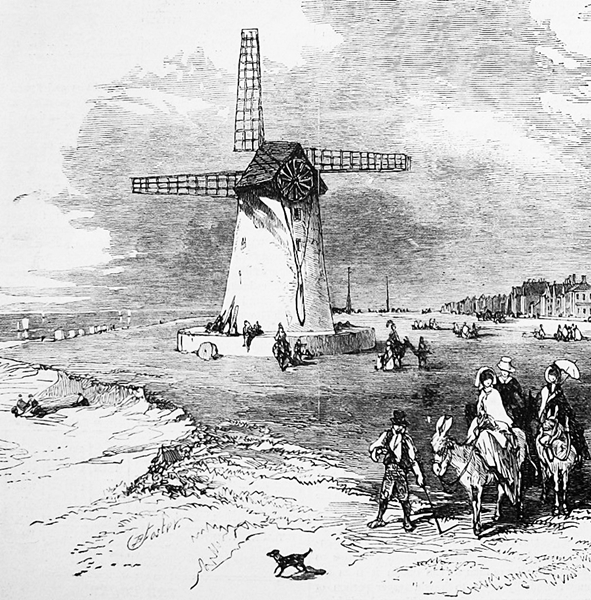
Lytham Windmill 1856, after the removal of the
kiln.
The miller's kiln, had been rebuilt in "Kiln Street"
at the East End of Lytham in the 1840s but a fire in 1859 virtually destroyed
it.
|
FIRE
Yesterday morning, between two and three
o'clock, the drying kiln belonging to the Lytham windmill was seen
to be on fire. An alarm was given and the neighbours assembled with
cans, and, with great exertions, the fire was got under about five
o'clock, but not before the roof and floors, and part of the walls,
had fallen in.
There were upwards of one hundred sacks of oats
belonging to farmers, and a large quantity of oats from the Robert
Henry, now lying on the Horse Bank, in the kiln at the time.
Preston
Guardian, Saturday,
December 17, 1859
|
|
|
1860s
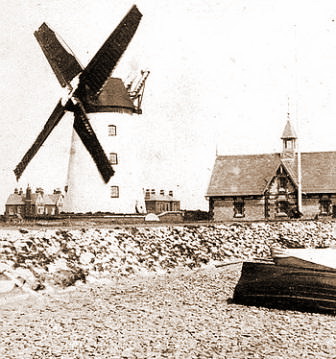
Lytham Windmill and new Lifeboat House in the
1860s.
The windmill was
again leased out by the Clifton Estate Office in 1863.
|
WIND MILL at Lytham,
TO BE LET BY PROPOSAL, and entered upon 1st May,
1863, all that well-accustomed MILL, on Lytham
Beach, containing three pairs of stones, viz., one French pair, one
gray do., for meal, and one pair of shelling stones, all in good
repair; together with extensive and convenient outbuildings, viz.,
drying kilns, rooms for storing corn, sheds, stabling, &c.,
Mr.Thomas Moore will show the premises, and
further particulars may be had at the ESTATE OFFICE,
LYTHAM.
|
William Cookson was born in 1820 and his parents,
George and Anne (Nancy), ran Eastham Farm. By the 1860s William was a "Provision
Dealer" living on Station Road, Lytham and he probably took the lease of the
windmill in 1863; he was certainly miller between 1871 & 1881.
|
|
1870s
|
A MAN KILLED IN A WINDMILL
The coroner, Mr. Gilbertson, on Monday held an
inquest at the police station, Lytham, on the body of a man named
William Westbrook, who met with his death in an uncommon way on
Friday last.
After having driven a lady to Lytham windmill
from Warton, he got on to the balcony of the mill, and was walking
round to go inside, when one of the sails struck him, rendering him
senseless.
He was immediately taken to the Infirmary there,
but soon died, not becoming conscious again. After hearing evidence
showing that the death was purely accidental, the jury returned a
verdict accordingly.
Lancaster Gazette -
Saturday 06 November 1875
|
|
|
1880s
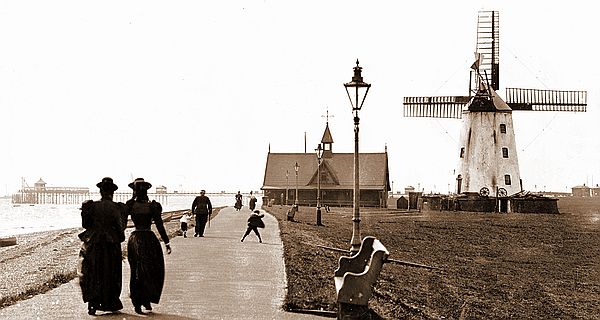
The windmill was again leased out by the
Estate Office in 1881. William Cookson's son George was the
tenant by 1881 when the advert below appeared in the local newspaper. John
Dickinson leased the mill from 1881, and after him came Thomas Baines and
then William Shuttleworth. William Swann was the last miller at
Lytham, from 1895 until 1919.

Advert for the lease of Lytham Windmill,
1881.
|
|
1890s
|
The Dangers of Lytham
Windmill.
On Tuesday evening a boy named Nottingham
received injuries at Lytham from which it is thought death will
result. He was playing on the embankment round the windmill on the
beach when he was struck by one of the sails.
He was found unconscious in a pool of blood. He
was conveyed to the hospital, where it was discovered he had lost a
large quantity of blood, and suffered from a fractured skull and
jaw and a lacerated neck. The doctor has little hope of
recovery.
Blackburn Standard - Saturday 07
April 1894
|
|
|
Lytham Windmill in the 20th
Century
|
|
|